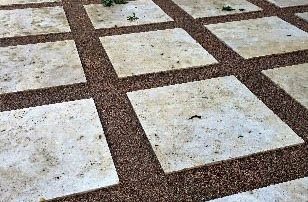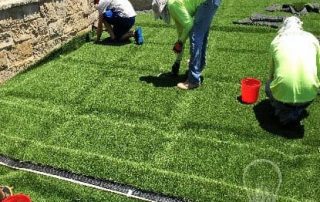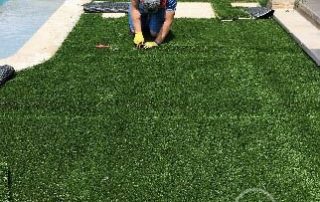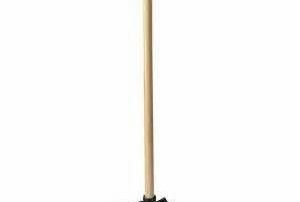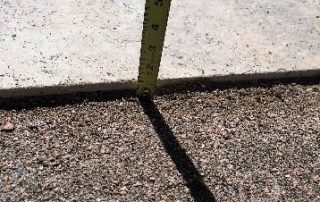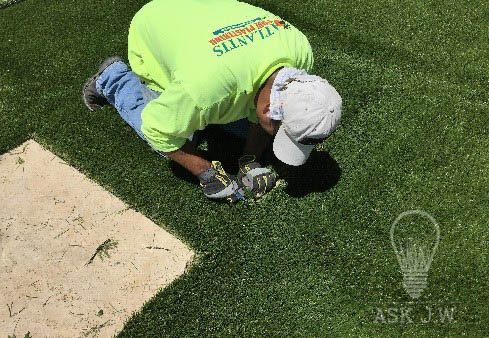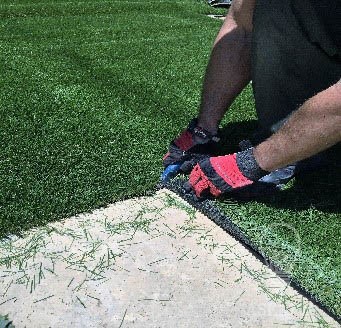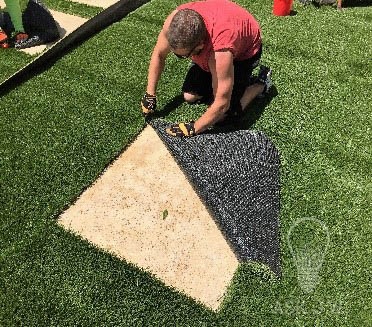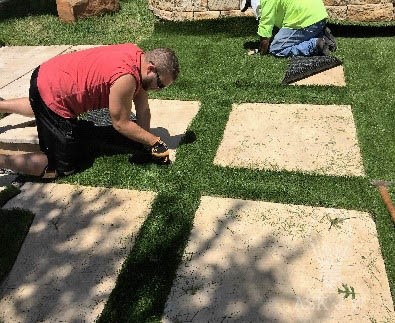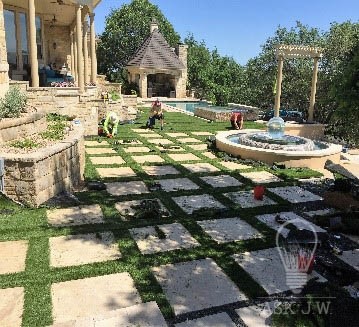Synthetic Turf Ribbons
Synthetic Turf Incorporated In and Between Hardscape has Become a New Trend


Placing synthetic turf in between concrete, pavers, travertine, or flagstone can magnify the beauty of the projects design. Placing synthetic turf ribbons in between these type of hardscapes can be challenging. If the installation is not planned out prior to the installation, the end result can be a nightmare.
I have trained many companies to install “Turf Ribbons” but have also watched contractors remove the entire project due to not knowing the proper way to install synthetic turf ribbons. Before you take on such a project you must understand the process. You may lose thousands of dollars if this process is not planned and estimated properly.
“Don’t let the waste factor become your wallets enemy” Ask JW
This month’s ASK JW, I will teach you the proper way to incorporate synthetic turf ribbons into your hardscape.

Pre-Planning
The very first step in bidding a project of incorporating synthetic turf ribbons in and between hardscape, you must educate the client the proper way their project must be installed. The client should be informed about the waste and cost it will take in order for the installation of turf ribbons to be installed correctly. I am sure the client is getting multiple estimates from other synthetic turf companies, so it is advisable to explain why there will be waste in order to have a successful installation. In the long run you will save labor costs and call backs by using large sections of turf and cutting out the hardscape instead of using pieces and strips.
When incorporating synthetic turf ribbons, it starts with the hardscape contractor. Contractors that place concrete, pavers, travertine, marble or flagstone rock will place the hardscape over a concrete bed or an exterior poured in place concrete edge to structurally hold the hardscape in place. This exterior concreted edge will cause difficulty in placing the correct amount of compacted imported subgrade materials to install the turf on. This exterior concrete edge will also cause difficulty securing the turf ribbons. It is advantageous to communicate with the hardscape contractor prior to the installation to ensure the edge of hardscape will not run past the line of your nailing edge. If this happens you will need to either saw cut or remove the overflow of the concrete, or drill and conset (drill and anchor) the turf ribbons with concrete fasteners.
Grading of imported compacted drainage soils
When installing synthetic turf ribbons make sure there is proper drainage. Installing turf ribbons within flat or level hardscapes that have minimum or no positive drainage can lead to flooding and an unhappy client. When placing the imported drainage fill, make sure it is of good quality that will allow water penetration.
The elevation of the drainage fill must be no more than 1/2 inch below all hardscape after compaction. This will prevent any trip hazards or toe stubbing after years of foot traffic.
When compacting the imported drainage fill, I recommend using a hand tamper to compact properly. If the drainage fill is not compacted at least 80% the turf ribbons will settle over time and you will have to remove and replace and start all over again. Be careful when compacting with the hand tamper so you don’t chip or damage the hardscape. When the compaction is complete make sure the imported drainage fill is dry and tight. This will allow for the proper securing of the turf ribbons.
When installing the synthetic turf I recommend using large sections of turf instead of strips. Depending on the size of the project you can actually save days of labor and materials by using large sections instead of seam tape and gluing sections and pieces together.
Lay-out
If you work hand and hand with the hardscape contractor you can educate his sales team about the lay-out of the designed ribbons in 15 feet increments. This will allow having to piece in small sections of cutting off unnecessary waste.
I recommend laying the synthetic turf sections where the fibers face toward the focal point. If this is not an option, when placing the infill the fibers must be fibrillated vertical so there is no “sheen or shine”.
When the sections are placed make sure that each sections gauges line up so that there is no difference in alignment.
Place and align sections over hardscape and allow to sit for at least an hour. This will allow the turf to settle and conform to the ribbon space. To speed up the settlement of the turf in between the hardscape, I recommend slowly walking on the turf prior to securing to allow the turf to conform.
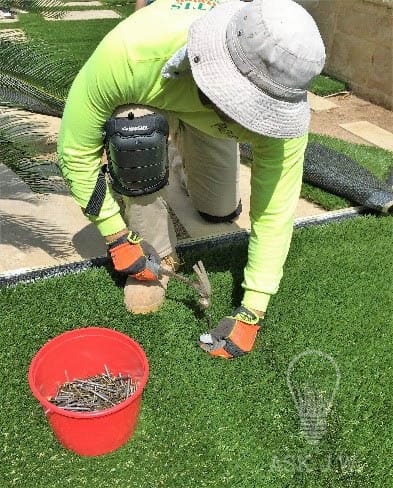
Securing of Turf Ribbons
Place spikes/nails in the center of each ribbon approximately 1′ apart. This will prevent the turf sections from moving during cutting.
Cutting Turf Ribbons
After all the turf sections are secure take a sharp knife and cut a small opening into the top of the turf at the edge of the hardscape. Follow the edge of the hardscape cutting the turf along the edge until you reach back to the starting point of cutting. Remove the middle section and move on to the next area to be cut out. Once all sections are cut and removed it is time to secure.
- Secure edges by using 5 inch nails (40d) every 16 inches at all edges and 5 inch nails (40d) every 12 inches down the center of ribbon.
- Place 3 ½ inch (16d common sinkers-framing nails) every 4 inches on center between the 5 inch (40d) nails placed at the edge of hardscape.
When installing turf ribbons it requires many nails to secure the edge. The less manipulation and smaller nail head will hide nail placement. The 16d nail heads are much smaller than the 5 inch nails and will not trap the fibers. When the soil bonds to the oxidization from the nail it will petrify and secure the synthetic turfs edge.
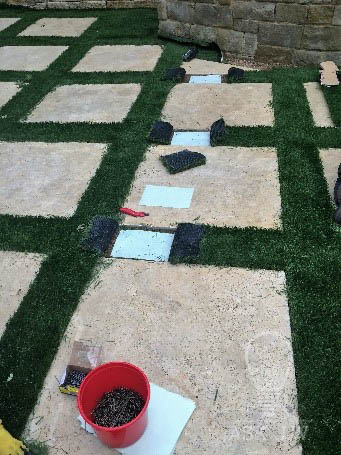
Seam tape & Glue
When all the sections are cut I recommend using SGW seam tape and Superseam Pro Glue to adhere the sections together. When all the turf ribbons are cut and secured it is time for the infill process.
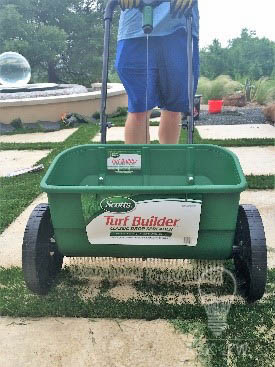
Infilling of Turf Ribbons
When infilling Synthetic turf ribbons, placing infill is a crucial step in completing a successful Installation. Since the area of ribbons are small I recommend placing smaller infill. Infill by hand or stay focused on the amount of infill dropped at one time. Using a drop spreader will lesson controllability and will cause the turf fibers to be trapped by placing too much infill. SO PLEASE INFILL SLOWLY.
Fibrillating of Turf Fibers
Excessive brushing and fibrillating will cause the edges to lift and extracting of the edge nails. I would take a stiff hand brush and brush the fibers vertical. If the ribbons are big enough then a power broom may be used. (Be careful not to lift edges)
For more information regarding the installation of synthetic turf ribbons contact J.W. askjw@sgwcorp.com or call 888.846.3598


